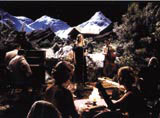Set point
Eve Stewart is tipped to win an Oscar next year for her work on the film Vera Drake.

Like an invading army, the film crew pulled up outside the RAC Club in London’s Pall Mall in a convoy of huge white trucks, groaning with cables, cameras, and crew. They were all here to do a night shoot for the new Guy Ritchie film, Revolver. I am here to meet the film’s designer, Eve Stewart, who is hotly tipped for an Oscar nomination for her set design work on Mike Leigh’s new film, Vera Drake, which opens next year. If she wins the Academy Award, it will catapult her into the premier league of international film designers and send her fees into orbit.
But within minutes of meeting her, you feel such an elevation would make no difference at all to Stewart. She is strikingly down to earth and matey. Some people get on in life because they are ruthless and self-seeking, others because they are hard-working, talented and appreciative of their co-workers. Stewart falls soundly into the latter bunch.
The first thing she does on arrival at the RAC Club is buy herself and me a drink, since an absence of neckwear disqualifies me from entering the bar. Clearly, this is a person who likes to ensure the people around her are comfortable and cared for.
Her route to top film designer has been an interesting and eclectic one. She studied theatre design at the Central St Martins College of Art and Design, under Alison Chitty, before winning an Arts Council bursary to do a year’s work at Nottingham Playhouse. While at college, to support herself, she wrote to Harvey Nichols saying she could do a better job on its window displays. Impressed by her portfolio, they let her loose on a number of promotions, including the food hall, for which she designed a 55m-long salmon made out of lids from tinned salmon cans, supplied by John West.
Working with the distinguished writer-director Peter Gill at the National Theatre Studio provided a great lesson in paring everything down, since there was never any budget for design. From there she went to a new theatre-in-the-round in Stoke, as head of design.
‘I’d been working quite happily in the theatre for several years when I suddenly became aware of its transient nature,’ she says. ‘I got fed up seeing all my lovely sets and artefacts being chucked into skips at the end of the run. I thought it would be nice to do something that would last.’
It was Chitty, her art college mentor, who recruited her as art director on Mike Leigh’s 1993 film Naked. Stewart and Leigh had worked together at Hampstead Theatre several years earlier on his play, Smelling A Rat. She went on to do five other films with the director, most recently the controversial Vera Drake.
Winner of best film at this year’s Venice Film Festival, Vera Drake takes a sympathetic view of a backstreet abortionist in London in the 1950s. A genuinely warm-hearted soul, Vera (Imelda Staunton) has convinced herself that ‘helping young girls in trouble’, as she puts it, is in society’s best interests. Despite Vera’s cheerful disposition, the mood of the film is unremittingly bleak, and this is reflected by a succession of dingy interiors, enlivened only by an occasional glimpse of heavily patterned wallpaper.
‘Obviously, we know each other’s strengths and weaknesses after so long together, but [Leigh] is still incredibly exacting and determined that everything should serve the story. In terms of design, he can’t bear things being there for their own sake. He notices everything,’ she says.
‘Quite often the research I do informs the artistic decisions he makes, if it is something to do with the look of a scene,’ she explains. ‘For instance, I chose the lightbulb factory as the workplace of Ethel, the dim-witted daughter, because he wanted somewhere sparky to contrast with her dimness. The lights are on but there’s nobody in, that sort of thing.
‘We started off filming the domestic interiors in an actual fourth-floor Peabody flat on an estate in Bethnal Green, but in the end we had to reproduce it somewhere else because the stairs were killing everyone. Other scenes were filmed in a disused nursing home in Crouch End. You spend a lot of time looking for locations, which isn’t very glamorous,’ she adds.
In contrast, Ritchie’s film Revolver, an apocalyptic tale of good and evil, seems to have allowed Stewart much more scope for spontaneity and creative input.
‘[Ritchie] is smart enough not to pretend he knows it all. He picks up on other people’s ideas and runs with them. It is a very fast shoot, so a lot of ideas are being thrown around all the time. It’s really good to indulge a bit of style for style’s sake, which is what he is into,’ she says.
Stewart’s other big project this year was a horror film called The Dark, in which she had to build a fantasy house suspended in a supernatural world. ‘The best bit for me was making up this glutinous tar-like substance which we chucked at the walls, then sprayed with button polish, to look as if the walls were oozing a kind of death juice, she says. We had a great time doing that – I knew just how Jackson Pollock must have felt when he did his splatter paintings.’
Vera Drake opens in the UK on 7 January
-
Post a comment




